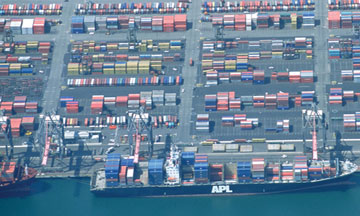LOGISTICS
Broadest Scale Yet
Anybody's sense of scale would be challenged by the size of the new Airbus A380, which will soon begin calling at WorldPort as well as the FedEx hub in Memphis. One A380 can carry 330,000 lbs. of cargo, as opposed to two planes carrying 180,000 lbs. each. That means more efficient use of landing and parking slots. Asked how the new plane affects facility design, Scherrens says the biggest impact is on airport infrastructure.
"The real impact revolves around our ability to move that aircraft around once it hits the ground," explains Jon Brugman. For one thing, the
 |
| APL's Global Gateway South terminal at the Port of Los Angeles in 2005 became the first to use a Real Time Locating System (RTLS) to find and track containers. Accurate to within one parking space, the new system has cut misplaced containers by 70 percent. Global Gateway South was recently voted the best ocean terminal in the LA- Long Beach harbor by the California Trucking Association. |
"Larger aircraft had been parking on ramp space closer to the freight facility," says Giuffre. "Because of the wingspan on the [A380] aircraft itself, changes have been made to the ramp space for parking those aircraft, which means relocation of some facilties already on the property."
The real competitive advantage to the "winged" design of WorldPort is its 44 on- building docking positions, enabling immediate offload of parcels. The expansion will bring the number of those positions to 80. Scherrens says on- building operations enable unloading and loading to occur in roughly half the time it would take at a traditional off- wing or tug- and- dolly operation, though some aircraft still must be served by the latter method.
Asked what the WorldPort growth has meant for the Supply Chain Solutions business, Giuffre says it provides more opportunities for UPS customers "as we continue to drive further into their supply chains." SCS in early August was voted the No. 1 third- party logistics provider in the world by more than 3,500 respondents in Inbound Logistics' annual survey. The current six- building complex serves more than 70 customers. Giuffre explains that late- night pickups from facilities close to the airport aren't just important in terms of physical location, but in terms of productivity too.
"It's changing around the way they do things," he says. "In a traditional warehouse environment, you may start around 9 a.m. and go til seven or eight at night. With a Supply Chain Solutions facility and end- of- runway service, you get there as early as four or five in the morning and can process til midnight. You turn it into a 21- hour processing window."
The ripple effect extends to those who might not need late- night pickup, but need immediate access, which means a lot of development opportunity for any territory within an hour's drive. Hindman says the additional road traffic attached to the increased logistics activity has not appreciably clogged the road network, in part because many of the incremental traffic increases are at off hours.
The internal ripple effect is already being felt: UPS is expanding sort capacity to 121,000 packages per hour with a $25- million project at one of its major secondary hubs in Rockford, Ill., where another heavy freight facility is also being constructed. Two hundred new jobs will be added to the current Rockford payroll of 1,450, in a town that is also home to a new $100- million distribution center from Lowe's and multiple expansions involving DaimlerChrysler's Belvidere assembly plant and its network of suppliers. Rockford's also now home to the fourth- fastest growing airport in the country in Chicago/Rockford International Airport, which just saw a year- over- year 14.2- percent increase in cargo tonnage.
The ripple extends to places like Manchester, N.H., where Louisville sends two planes a day and is looking to add 22 truck bays.
But the ultimate ripple is the one that bumps up against the shore.
"We're clearly starting to push the limits of available land," says Scherrens, "but this will satisfy our needs for quite a few years down the road. We have ways to increase capacity from our existing sortation system. And the airport to date has always come up with a way to do it.
"The next expansion," he says, "will get the same level of evaluation."

